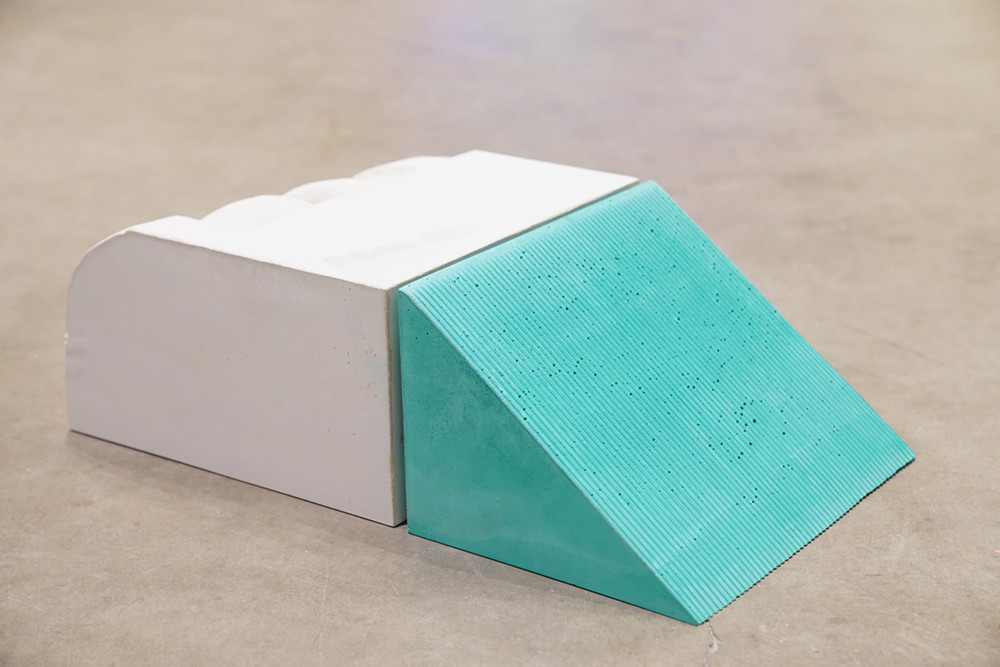[ad_1]
In 1965 William T. Wiley purchased a steeply inclined step stool covered in green linoleum from a salvage store in Mill Valley, California, and gifted it to his student Bruce Nauman. The two artists became obsessed with the ambiguity of the “slant step,” whose origins and function are still a mystery, and the object captured the imagination of numerous artists in their circle over the next several years. On the occasion of the fiftieth anniversary of Sacramento-based artist and poet Phil Weidman’s 1969 Slant Step Book—a compilation of artists’ projects inspired by the object—the exhibition “Slant Step Forward” honored this unlikely touchstone of 1960s art, bringing together works included in the book and in related shows. Curator Francesca Wilmott also commissioned seven contemporary artists to respond to the object, extending the artistic dialogue catalyzed by the slant step to a new generation. These contemporary works introduced a queer spin to the slant step tradition, which was dominated in the 1960s by heterosexual male artists.
Wilmott framed the show around Slant Step Book partly as a means of foregrounding the role of Sacramento artists in the slant step’s history. The exhibition highlighted the work of local figures like Ron Peetz, whose Slant Step X-Ray (2004, based on a 1969 work) is an X-ray providing an interior view of the humble object.
The interweaving of the two generations didn’t entirely convince, nor should it have. Though all the artists in the show took the same object as a point of departure, they used it to explore different concerns. Many of the early works are jokey, macho, and self-mocking. A 1969 mail-art work by Ray Johnson, Duck Slant Step Pets, maps the names of the figures involved with the slant step around a horse/foot figure (a sendup of the classic rabbit/duck illusion), and was addressed to critic Rosalind “Con-Stable.” A 1966 sculpture by Wiley, Slant Step Becomes Rhino/Rhino Becomes Slant Step, looks more like a medieval torture chair than a step stool, with a phallic tusk sticking up from its seat.
Photo Scott Duncan.
Whereas the slant step works from the 1960s are funky and experimental, the exhibition’s contemporary responses (all 2019) are generally more conceptual, formally refined, politically oriented, and cognizant of the gallery space, using the slant step’s awkward form to explore themes of gender trouble and body politics. Gordon Hall’s Two Part Object (After the Slant Step) combines two concrete objects—one white and curved, the other turquoise and aggressively slanted—and was placed at the entrance to the gallery, where it could literally trip visitors, while Terry Berlier’s “Nonorientable” sculptures consist of wooden Möbius strips that transform the angled step into circular bodies that rest lithely on pillows. Aay Preston-Myint’s two “Untitled (Fetish Object)” sculptural collages turn the slant step into a glory hole, and soften the object’s hard edge with purple draperies.
The handsome two-volume publication accompanying the show includes a facsimile of Weidman’s 1969 book and an exhibition catalogue, the latter replete with essays and artists’ texts, such as Hall’s 2016 “Reading Things,” which uses the ambiguity of the slant step to think through the North Carolina “bathroom bill” restricting bathroom access for transgender people. The publication’s oppositional arrangement is perfect: rather than trying to suture the different impulses and aesthetics together, it emphasizes the distance separating these two generations and two world views, with only a step stool as a bridge.
This article appears under the title “’Slant Step Forward’” in the January 2020 issue, pp. 85.
[ad_2]
Source link


